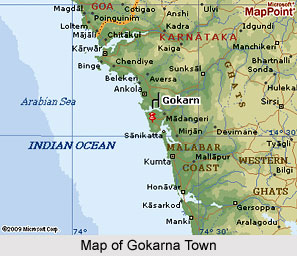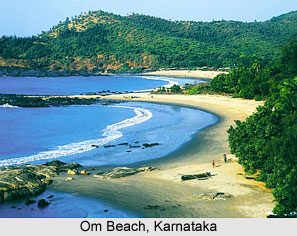 Gokarna town is located in the Uttara Kannada District in the southern Indian state of Karnataka. A popular Hindu pilgrimage spot, Gokarna is also an interesting tourism locale, which finds mention in innumerable literary historical pieces. Lord Mahabaleshwar, another avatar of Lord Shiva is the presiding deity of these temples. Several beautiful beaches dot the region around Gokarna, which are visited by many travellers.
Gokarna town is located in the Uttara Kannada District in the southern Indian state of Karnataka. A popular Hindu pilgrimage spot, Gokarna is also an interesting tourism locale, which finds mention in innumerable literary historical pieces. Lord Mahabaleshwar, another avatar of Lord Shiva is the presiding deity of these temples. Several beautiful beaches dot the region around Gokarna, which are visited by many travellers.
The term `Gokarna` implies the ear of a cow. A popular belief states that Lord Shiva had appeared from a cow`s ears, the cow being `Prithvi` or planet earth, who is revered as Mother. The confluence of the rivers Aghanashini and Gangavalli is considered to be the place represented by the present-day Gokarna.
Location of Gokarna
Gokarna is located at a distance of nearly 583 km from Bangalore, 59 km from Karwar and 238 km from the northern part of Mangalore. This town is present between Agnashini River and Gangavali River and is based along the Karwar coast. It is about 200 km from the northern part of the towns of Manipal and Suratkal.
Mythological History of Gokarna
A legendary tale in the Sahyadri Khand of the Puranas assert that the sage Parashurama, who had migrated from the northern parts of the Vindhya Mountain ranges had restored Kerala from the sea, after he had returned from his wandering. During his wanderings, it is believed that he had killed `Kshatriyas` as many as 21 times and threw the axe, with which he murdered the Kshatriyas into the sea. This was done to check land erosion of the portion of the land which extended to the southernmost tip of the country, starting from Gokarna. The Shrimad Bhagavata Purana has also referred to the town of Gokarna, as the abode of the brothers Dhundhakari and Gokarna.
 The `Sthanapuranam` of Gokarna, which during that time was available in the Tamil language, particularly during `sangam` times, states that when Lord Brahma was offering his penance to restore himself from the curse of `shivan`, which was a consequence of his arrogance he had displayed after he created the universe, Lord Shiva presented His divine, appearing from a cow`s ears. Thereafter, this very region came to be known as `gokarnam` or the ear of a cow. Gokarna town was a portion of the state of Tamil Nadu, and was preciously known as `Konkanam`, which constitutes the modern-day Konkan.
The `Sthanapuranam` of Gokarna, which during that time was available in the Tamil language, particularly during `sangam` times, states that when Lord Brahma was offering his penance to restore himself from the curse of `shivan`, which was a consequence of his arrogance he had displayed after he created the universe, Lord Shiva presented His divine, appearing from a cow`s ears. Thereafter, this very region came to be known as `gokarnam` or the ear of a cow. Gokarna town was a portion of the state of Tamil Nadu, and was preciously known as `Konkanam`, which constitutes the modern-day Konkan.
Ancient History of Gokarna
The most ancient historical accounts of Gokarna are shrouded in mystery. Tamil saints like Sambanthar and Nayanmars Appar who belonged to the 6th century and settles in Gokarna were devoted to the deity of Tulu Nadu, who finds mention in `Tevaram`, the name of their hymns. Historians have maintained that several Brahmins were brought by the King Mayurvarma of the Kadamba rulers to Gokarna, from the area of Ahicchatra. Some Brahmins had retreated from Gomantak to Gokarna, in order to free themselves from the forcible conversions practised by the British and Portuguese who were based in Gokarna around the 15th century. Gokarna was a portion of Vijayanagar Empire and Sodhe. When the Konkan coast, which included Goa was occupied by the Portuguese, the area of Gokarna was annexed by the Portuguese rulers in this part of India. Some of the temples located in Gokarna were demolished by the Portuguese in the year 1741 and later reconstructed towards the 18th century. This wad carried out under the surveillance of Shrimat Anandashram Swamiji in the year 1928.
Culture of Gokarna
The temple town of Gokarna is filled with palm and coconut trees. There are two major streets in this town, which consist of neat, traditional houses made of bricks and equipped with tiled roofs. It is an ideal paradise for the hippies, who wander from one place to the other, carrying musical instruments like guitar, hammocks and drums. Huts or shacks which are available for rent are present near Gokarna. Marathi, Konkani and Kannada are the common languages utilized by the regional inhabitants of Gokarna. `Kartika Mahotsava` and `Mahashivratri` are the festivals which are celebrated by the local communities of Gokarna. Gokarna is said to be an important hub for imbibing knowledge in the Sanskrit language and Toggu Math and Bhandikeri Math are renowned for their imparting lessons in Sanskrit works.
Tourism in Gokarna
Gokarna houses numerous temples like Mahabaleshwar Temple, Maha Ganapathi Temple, Tamra Gauri Temple, Bhadrakali Temple, Venkataramana Temple, Uma Maheswari Temple and others. There also exists an artificial tank, named `Kotitheertha` which is utilized for ritual bathing and immersion of idols. The festival of `Shivaratri` is observed with great pomp and gaiety in Gokarna. Elaborate rites and rituals accompany the celebration of Mahashivaratri. During this festival, over 20, 000 pilgrims throng the town of Gokarna. Rocky mountains of the Western Ghats and spectacular natural beauty exuded by Om Beach, Half Moon Beach, Kuddle Beach, Main Beach, Paradise Beach and Nirvana Beach are amongst the magnificent tourist destinations of Gokarna town.



















